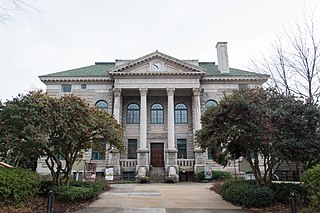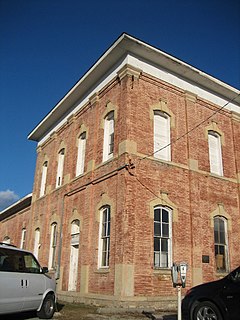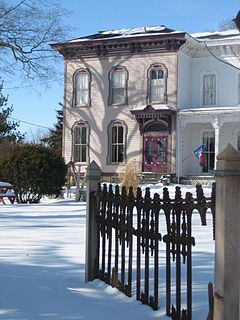
DeKalb County is a county located in the U.S. state of Illinois. As of the 2020 United States Census, the population was 100,420. Its county seat is Sycamore.

Decatur is a city in, and the county seat of, DeKalb County, Georgia, which is part of the Atlanta metropolitan area. With a population of 24,928 in the 2020 census, the municipality is sometimes assumed to be larger since multiple ZIP Codes in unincorporated DeKalb County bear Decatur as the address. The city is served by three MARTA rail stations. The city is located approximately 5 miles (8.0 km) northeast of Downtown Atlanta and shares its western border with both the city of Atlanta and unincorporated DeKalb County. The Druid Hills neighborhood is to the northwest of Decatur. The unofficial motto of Decatur used by some residents is "Everything is Greater in Decatur."

Sycamore is a city in DeKalb County, Illinois, United States. It has a commercial district based and centered on Illinois Route 64. The population was 17,519 at the 2010 census, up from 12,020 in 2000. As of 2019, the population has grown to an estimated 18,322. Sycamore is the county seat of DeKalb County and was named after the sycamore tree.

The Sycamore Historic District is a meandering area encompassing 99 acres (400,000 m2) of the land in and around the downtown of the DeKalb County, Illinois county seat, Sycamore. The area includes historic buildings and a number of historical and Victorian homes. Some significant structures are among those located within the Historic District including the DeKalb County Courthouse and the Sycamore Public Library. The district has been listed on the National Register of Historic Places since May 2, 1978.

The William W. Marsh House in Sycamore, Illinois, the county seat of DeKalb County, has been listed on the National Register of Historic Places since 1978. The 1873 house was home to William W. Marsh, an inventor and is located along Illinois Route 64 as it passes through Sycamore. The Marsh House was built in the Italianate style and contains distinctive Italianate elements such as a cupola, a low pitched roof and eaves supported by corbels.

The Chicago and Northwestern Depot is a historic railway station located at the northeast corner of Sacramento and DeKalb Streets in Sycamore, Illinois. The station was built in 1865 to serve as Sycamore's main railway station. While Sycamore was bypassed by the Chicago and Northwestern Railway (C&NW) in the early 1850s, several community leaders developed and built the Sycamore, Cortland, and Chicago Railway to link Sycamore to the C&NW at Cortland. The original line, which opened in 1855, lacked an engine and pulled railcars by mule; as the railway became more successful, it was able to purchase an engine and build the station in Sycamore. The station has an Italianate design which resembles contemporary DeKalb architecture but is noticeably different from the standardized depots built elsewhere in the C&NW system. The branch and station were acquired by the C&NW in 1883.

The DeKalb County Courthouse is located in the county seat of DeKalb County, Illinois, U.S., the city of Sycamore. The Classical Revival structure sits on a square facing Illinois Route 64 as it passes through the city. The current courthouse was constructed in 1905 amid controversy over where the courthouse and thus, ultimately, the county seat would be located. The current building is the third structure to bear the name "DeKalb County Courthouse." DeKalb County's Courthouse still serves as the county's primary judicial center and is a contributing property to the Sycamore Historic District. The district joined the National Register of Historic Places in 1978. As the county's primary courthouse for over 100 years, the site has been host to many trials, including prominent murder cases.

The D. B. James House is located in Sycamore, Illinois and is part of the Sycamore Historic District. The district was entered on the National Register of Historic Places in 1978. The James House is one of 226 properties located within the district boundaries. It stands on the corner of Exchange and Main Streets behind the DeKalb County Courthouse.

The Frederick B. Townsend House is located in the DeKalb County, Illinois county seat of Sycamore. The home is within the boundaries of the Sycamore Historic District. The district was designated and listed on the National Register of Historic Places in May 1978. The Queen Anne style home was designed and constructed in 1890 or 1892 by the same architect and general contractor responsible for Altgeld Hall at Northern Illinois University and the nearby DeKalb County Courthouse, as well as the courthouse in Lee County.

The Charles O. Boynton House is located in the DeKalb County, Illinois, city of Sycamore. The home is part of the Sycamore Historic District which was designated and listed on the National Register of Historic Places in May 1978. The Queen Anne style mansion sits on a stretch of Sycamore's Main Street that is dotted with other significant Historic District structures including, the Townsend House and the Townsend Garage. The Boynton House was designed by the same architect who designed the Ellwood House in nearby DeKalb and the David Syme House, another house in the Sycamore Historic District.

The Civil War Memorial, in the DeKalb County county seat of Sycamore, Illinois, United States, is located in front of the DeKalb County Courthouse on a public square. The memorial was erected in 1896 and dedicated in 1897. The structure is a memorial to the thousands of DeKalb County residents who served in the American Civil War. It incorporates an obelisk which rises to 50 feet in height. The base is adorned with copper sculpture, completed by an unknown sculptor. On the east facade of the memorial the word "Antietam", denoting the Battle of Antietam, is misspelled. This work of public art underwent its first restoration work in 2005-2006.

The Chauncey Ellwood House is a 19th-century Italianate residence in the DeKalb County, Illinois city of Sycamore. It is a contributing property to the Sycamore Historic District; added to the National Register of Historic Places in 1978. The house is in the 800 block of Somonauk Street. The Esther Mae Nesbitt House, next door, was once the carriage house for the home.

Old Sycamore Hospital is two-story brick structure in downtown Sycamore, Illinois, United States. It is a contributing structure within the Sycamore Historic District. The district was established when it was added to the National Register of Historic Places in 1978. The hospital building is located at the corner of Elm and Somonauk Streets in Sycamore.

The Carlos Lattin House was built by Sycamore, Illinois' first permanent settler, Carlos Lattin. It lies within the boundaries of the Sycamore Historic District and is listed as one of the contributing structures in the district. The Sycamore Historic District was added to the National Register of Historic Places in 1978.

The Charles O. Boynton Carriage House is a prominent structure in the Sycamore Historic District, located in Sycamore, Illinois. The Sycamore Historic District was added to the National Register of Historic Places in 1978. The Carriage House is considered one of more than 150 contributing properties to the overall historic integrity of the district.

The Peter Johnsen Rooming House is an historic building near downtown Sycamore, Illinois. The red brick structure stands in the 100 block of South Main Street and is considered a contributing structure to the overall historic integrity of the Sycamore Historic District. The district was added to the National Register of Historic Places in May 1978.

The houses in the Sycamore Historic District, in Sycamore, Illinois, United States, cross a variety of architectural styles and span from the 1830s to the early 20th century. There are 187 contributing properties within the historic district, 75% of the districts buildings. Many of the homes are associated with early Sycamore residents, usually prominent business leaders or politicians. Houses within the district are known by, either their street address or by a name associated with a prominent owner or builder. For most of the houses, the latter is true.

As of 2007 there are five church buildings in the Sycamore Historic District, located in Sycamore, Illinois, United States which are listed as contributing properties to the district. The Sycamore Historic District was added to the U.S. National Register of Historic Places on May 2, 1978. When it was nominated to join the National Register there were seven church buildings within the district. One of those included is a residential structure that was utilized as a church when it was first constructed; the Arthur Stark House was once home to the Sycamore Universalist Church congregation. In the time since its listing, two churches have been destroyed or demolished. The Evangelical Church of St. John was destroyed by fire in 2004 and the United Methodist Church in Sycamore is no longer extant, replaced by a modern office building.

The commercial buildings in the Sycamore Historic District, located in Sycamore, Illinois, United States are mostly located in and around the city's downtown. The largest concentration of commercial contributing properties to the historic district are found along Illinois Route 64 as it passes through Sycamore. They include several buildings known as "blocks" which can consist of more than one adjacent and attached structure, as is the case with the Waterman Block, one of the Sycamore commercial buildings.




















